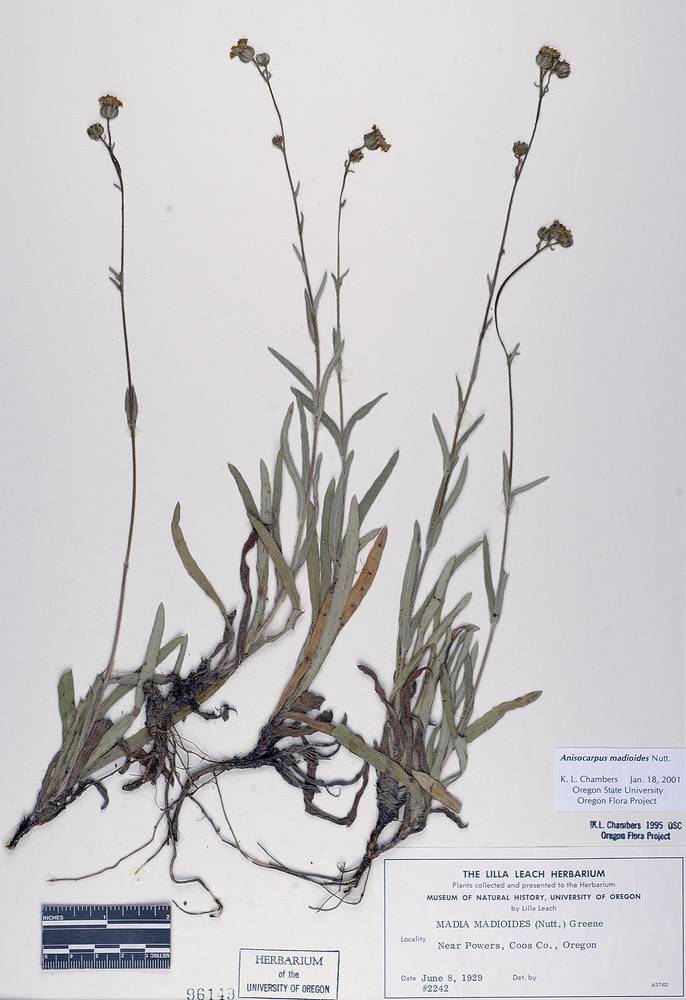
|
Family: Asteraceae |
Perennials, 10-80 cm. Stems erect, branched from bases or throughout. Leaves basal and cauline; proximal opposite (sometimes rosettes), distal alternate; ± sessile; blades oblong to linear, lance-linear, or oblanceolate, margins entire or toothed, faces hirsute to strigose or pubescent and (distal leaves) stipitate-glandular. Heads radiate or discoid, borne singly or in corymbiform or racemiform arrays. Peduncular bracts: pit-glands, tack-glands, and/or spines 0 at tips. Involucres ± globose or broadly ellipsoid to campanulate, 4-6+ mm diam. Phyllaries 0 (see paleae at receptacles) or falling, 1-3 or 7-15 in 1 series (lanceolate to lance-attenuate or oblanceolate, herbaceous, each 1/2 or fully enveloping subtended ray floret proximally, ciliolate, abaxially stipitate-glandular, sometimes hirtellous). Receptacles flat to convex, glabrous or setulose, paleate (paleae falling, in 1 series, between rays and discs, usually connate, sometimes distinct, phyllary-like, more scarious; in discoid heads, functionally an 'involucre'). Ray florets 0, 1-3, or 8-15, pistillate, fertile; corollas yellow. Disc florets 5-30, bisexual and fertile, or functionally staminate; corollas yellow, tubes shorter than funnelform throats, lobes 5, deltate (styles glabrous proximal to branches; anthers yellow). Ray cypselae (black or grayish) compressed or ± obcompressed, clavate, ± arcuate (basal attachments centered, apices beaked, beaks offset adaxially, 0.2-0.3 mm, faces glabrous or hairy); pappi 0 or coroniform. Disc cypselae (black or grayish) ± terete, clavate (± straight, faces hairy); pappi of 5-8 or 11-21 lanceolate, linear, quadrate, or subulate, ciliolate-plumose, erose, or fimbrillate scales. x = 7. Following B. G. Baldwin (1999b), Anisocarpus comprises two species that have resided in different genera and different tribes. Anisocarpus scabridus was placed in Raillardella or Raillardiopsis-both regarded as members of Senecioneae until S. Carlquist´s (1959) anatomic studies. Anisocarpus madioides was treated in Madia and included in D. D. Keck´s (1959) informal 'section Anisocarpus,' along with the other pappose species of Madia in the sense of Keck (now treated in Harmonia, Jensia, and Kyhosia). Molecular phylogenetic data support a sister-group relationship between A. madioides and A. scabridus (Baldwin 1996). Anisocarpus madioides and A. scabridus are the only perennial herbaceous tarweeds that combine non-scapiform capitulescences, radiate heads (at least in part), ellipsoid or spheric involucres, and yellow anthers, and are the only perennials in Madiinae with 2n = 14. The two species are highly distinct ecologically: A. madioides occurs in low- to mid-elevation, forest and woodland understories; A. scabridus occurs on high-elevation, exposed scree slopes and ridges. Artificial hybrids between the two species are vigorous, easily produced (with Anisocarpus madioides as seed parent), and largely pollen-sterile, except for large, diploid grains. B. G. Baldwin used diploid pollen from an F1 hybrid between A. madioides and A. scabridus in an artificial hybridization with a member of the closely-related Hawaiian silversword alliance, Dubautia knudsenii Hillebrand, a wet-forest tree from Kaua`i (see M. Barrier et al. 1999).
|
This project was made possible in part by the Institute of Museum and Library Services [MG-70-19-0057-19].
Powered by Symbiota



